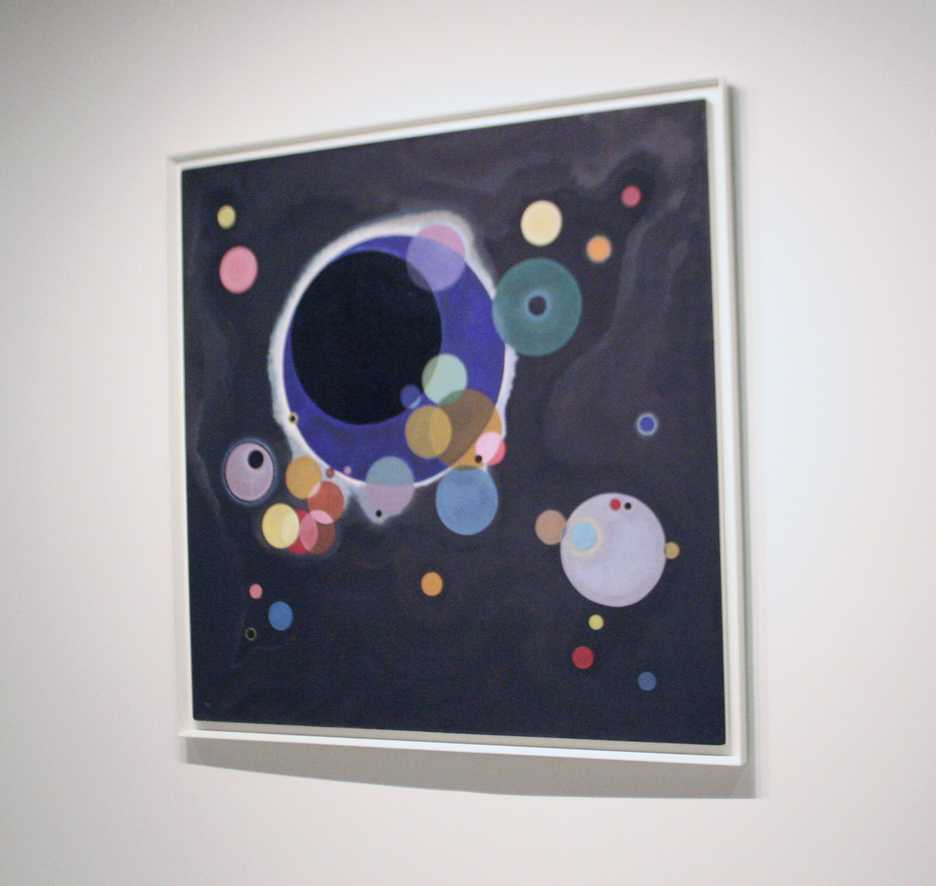Kandinsky’s Works Create “Lyrical” Celebration
For Its 50th Anniversary, The Guggenheim Displays Wassily Kandinsky’s Influential Paintings
June 27, 2011

Published: October 22, 2009
More than half a century since it opened as a platform to promote the abstract art movement, the Guggenheim Museum is celebrating in the most fitting way possible: showing the works of one of the original abstract artists, Wassily Kandinsky. On display until mid-January, Kandinsky’s abstract paintings and paper drawings are reborn in the house they inspired, with the complex, vibrant canvases resting poetically in the unadorned space. Gathered from the Guggenheim’s own collection, the Stadtische Galerie im Lenbachhaus in Munich, the Centre Pompidou in Paris and private collections, “Kandinsky” provides a comprehensive look at the life of an artist vital to the foundations of abstract art and of the Guggenheim museum itself.
The spearhead for Solomon R. Guggenheim’s rabid foray into the art scene, Kandinsky sought to create nonobjective art, disregarding the realism of external influences for internal, spiritual truths. The Russian-born ex-law student didn’t pursue art seriously until he was 30 years old, but his life thereafter was driven by groundbreaking strides in abstract painting and drawing. When Guggenheim began to take notice of Kandinsky in 1929, under the advisement of friend and abstract painter, Hilla Rebay, the artist had already achieved pure abstraction with 1911’s “Picture with a Circle” and had become an accomplished teacher at the famous Bauhaus school in Germany. Yet he continued to pursue radical ideas in his art—from geometric to biomorphic abstraction—until the end of his life. This endless pursuit is documented at the Guggenheim in nearly one hundred paintings dating from 1902 to 1942.
Accordingly, a walk up the Guggenheim’s famed spiral path allows visitors to take a journey through the notable events of Kandinsky’s life, both artistic and personal. Creating a brilliantly flowing arch of the artist’s life, the exhibition is divided into sections which chronicle his world travels and the paintings produced at each location. The first of the exhibit, “Training and Travels in Europe, 1896-1907,” follows Kandinsky as he becomes fascinated with the strong, yet intangible emotion created from orchestral music and Monet’s strong use of color. Seeking to derive the same force in his own paintings solely from these abstract elements, common, postcard-like scenes of Europe grow increasingly non-representational through Kandinsky’s unspecific forms and staccato brushstrokes.
The following section, “Munich and Murnau, 1908-14,” also focuses on landscapes, but the paintings display Kandinsky’s newfound freedom of color and confidence in abstract forms. “Lyrical,” painted in January 1911, depicts a horse whose body dissolves into a free-flowing storm of warm, tantalizing color. This painting, with its horse as a symbol of an idyllic land and a break from modern materialism, and only slightly identifiable as a representation of the real animal, declares Kandinsky’s opposition to the prevailing ideas of his day, socially and aesthetically.
Furthermore, “Lyrical,” as well as the other pieces made in Munich and Murnau establish some of Kandinsky’s longstanding recurring motifs such as “the horse and rider” and “the apocalypse.” With his abstract paintings, Kandinsky sought to achieve a purity and truthfulness that he believed had not existed since pre-Westernized Russia. Eventually, he thought, the world would experience a spiritual rebirth after an apocalyptic event. Stressing the importance of this return to spirituality, the clarity of Kandinsky’s motifs stands in stark contrast to the increasingly chaotic nature of the scenes depicted in his paintings.
Kandinsky’s rebellious spirit and search for salvation is continually felt throughout the entirety of his work following “Lyrical,” as we follow him to Moscow where he studies color and form, to Germany to teach at the Bauhaus school and then to Paris after the Nazis demonize him and the entirety of modern art. The paintings on display from 1933 until 1944, the years he spent in Paris, fully realize the abstractions he had chased since his earliest landscapes.
Painted in April of 1935, “Succession” is a standout piece in the collection, embodying Kandinsky’s artistic development and isolation nearing the end of his life. Opposed to the overwhelming embrace of Impressionism and Cubism that thrived in France at the time, “Succession” is abstract yet rigidly structured. Strange shapes dot the the canvas from left to right, each different than the last but militaristically ordered and linear—an image entirely at odds with the loose, flowing scenes of Impressionism. These imperfect forms, resembling organisms under a microscope, boldly contrast the perfect geometric shapes of Cubism. Contradictory yet harmonious, the images of “Succession” capture both the freedom of the individual and the oppression of the masses, ideas Kandinsky had explored all his life.
While the outstanding narrative of the exhibit provides a helpful context for the pieces on display, the structure of the Guggenheim truly unites the exhibition and highlights the beauty of Kandinsky’s work. Frank Lloyd Wright’s masterful design of the space allows Kandinsky’s artwork plenty of room to breathe—a requirement of his hectic paintings and those observing them. While the Guggenheim’s pathway offers little freedom for curators to experiment and perfect the viewing of specific exhibitions, here, it aids Kandinsky’s paintings beautifully, surrounding onlookers with the vibrancy, peculiarity and genius of his work. If there was ever a time to see Kandinsky, it’s now. Guggenheim himself would agree.









